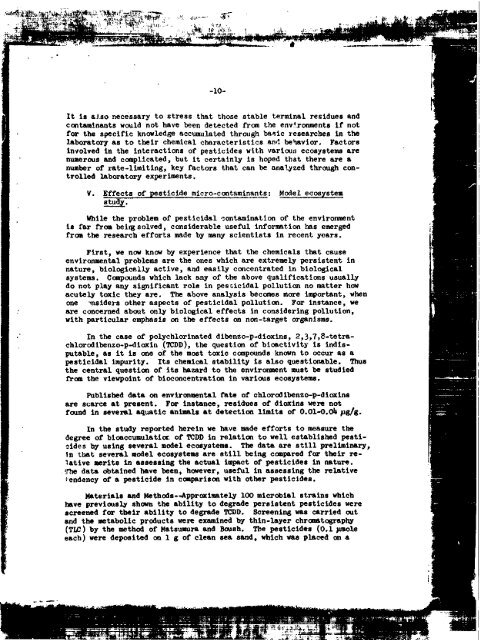Item ID Number - Special Collections
Item ID Number - Special Collections
Item ID Number - Special Collections
Create successful ePaper yourself
Turn your PDF publications into a flip-book with our unique Google optimized e-Paper software.
" •• • ' • > , • • - .<br />
-10-<br />
It is aJ.so necessary to stress that those stable terminal residues and<br />
contaminants would not have been detected from the environments if not<br />
for the specific knowledge accumulated through basic researches in the<br />
laboratory as to their chemical characteristics and behavior. Factors<br />
involved in the interactions of pesticides with variouii ecosystems are<br />
numerous and complicated, but it certainly is hoped that there are a<br />
number of rate-limiting, key factors that can be analyzed through controlled<br />
laboratory experiments.<br />
V. Effects of pesticide micro-contaminants:<br />
study.<br />
Model ecosystem<br />
While the problem of pesticidal contamination of the environment<br />
is far from beirg solved, considerable useful information has emerged<br />
from the research efforts made by many scientists in recent years.<br />
First, we now know by experience that the chemicals that cause<br />
environmental problems are the ones which are extremely persistent in<br />
nature, biologically active, and easily concentrated in biological<br />
systems. Compounds which lack any of the above qualifications usually<br />
do not play any significant role in pesoicidal pollution no matter how<br />
acutely toxic they are. The above analysis becomes more important, when<br />
one insiders other aspects of pesticidal pollution. For instance, we<br />
are concerned about only biological effects in considering pollution,<br />
with particular emphasis on the effects on non-target organisms.<br />
In the case of polychlorinated dibenzo-p-dioxins, 2,3,7,8-tetrachlorodibenzo-p-dioxin<br />
(TCDD), the question of bioactivity is indisputable,<br />
as it is one of the most toxic compounds known to occur as a<br />
pesticidal impurity. Its chemical stability is also questionable. Thus<br />
the central question of its hazard to the environment must be studied<br />
from the viewpoint of bioconcentration in various ecosystems.<br />
Published data on environmental fate of chlorodibenzo-p-dioxins<br />
are scarce at present. For instance, residues of dioxins were not<br />
found in several aquatic animals at detection limits of 0.01-0.0 1 * pg/g.<br />
In the study reported herein we have made efforts to measure the<br />
degree of bioaccumulatior. of TCDD in relation to well established pesticides<br />
by using several model ecosystems. The data are still preliminary,<br />
In that several model ecosystems are still being compared for their relative<br />
merits in assessing the actual impact of pesticides in nature.<br />
'The data obtained have been, however, useful in assessing the relative<br />
tendency of a pesticide in comparison with other pesticides.<br />
Materials and Methods—Approximately 100 microbial strains which<br />
have previously shown the ability to degrade persistent pesticides were<br />
screened for their ability to degrade TCDD. Screening was carried out<br />
and the metabolic products were examined by thin-layer chromatography<br />
(TLC) by the method of Matsumura and Boush. The pesticides (0.1 umole<br />
each) were deposited on 1 g of clean sea sand, which was placed on a<br />
Urn<br />
*7* TS '*" ''' *" '1
















